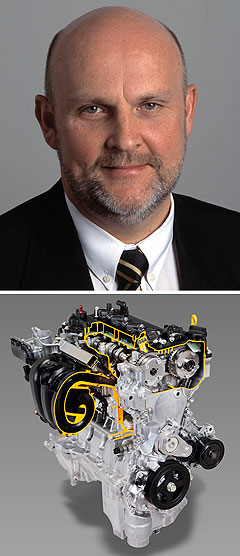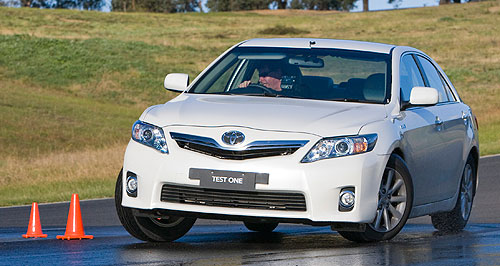Make / Model Search
News - Toyota - CamryToyota confirms next-gen Camry HybridIn the balance: Toyota's new AR 2.5-litre engine is destined for the next local Camry, but it might be imported. Next Toyota Camry to get a new engine, but it might not be built in Australia27 Jul 2010 TOYOTA Australia remains committed to a hybrid version of its next-generation Camry due on sale in 18 months, but mainstream versions might no longer be powered by a locally made engine. The fate of Toyota’s Australian engine plant will be decided by November this year at the latest, GoAuto can reveal. The decision rests on whether the Japanese company chooses to invest in local production of its all-new ‘AR’ 2.5-litre four-cylinder petrol engine at the Altona plant in Melbourne for the new Camry. Toyota Australia’s senior executive director of sales and marketing David Buttner confirmed that Toyota Australia would again market and build a hybrid version of the future Camry in Australia, despite sluggish sales of the current-generation model. “We will continue with the Camry Hybrid,” he told GoAuto at a Camry Hybrid performance evaluation drive in Victoria yesterday. As it already has in many other overseas markets, Toyota’s larger and more efficient new four-cylinder powerplant will replace the current 2.4-litre ‘AZ’ unit, which has been a fixture in the Australian-built mid-sized sedan since 2002, because the engine does not meet the future Euro 5 emissions standards due around 2013. If Toyota decides to import the AZ engine from another source – such as from Thailand or Japan – to slot into the Melbourne-made Camry, it will almost certainly spell the end of the 32-year-old Altona engine plant, as well as the 300 manufacturing jobs it supports.  Left: Toyota Australia’s senior executive director of sales and marketing David Buttner. Below: Toyota's AR 2.5-litre engine. Left: Toyota Australia’s senior executive director of sales and marketing David Buttner. Below: Toyota's AR 2.5-litre engine.However, according to Mr Buttner, a decision on the Camry engine either way would not necessarily mean a factory shutdown. “I’d like to think that it’s still safe,” he told GoAuto. “It has been a lengthy process for what has been the future of that plant, but I certainly believe that the plant has a very strong future. “Discussions are still underway, but it is still very positive for the engine plant ... with the decision still about four months away.” The next Camry – the seventh generation since the model debuted in Australia in 1983 – is on track to be launched late next year or in early 2012. It again will spawn a subtly modified V6 petrol version under the Aurion moniker, Toyota has said, to take on the locally manufactured Holden Commodore and Ford Falcon. Asked if there was discussion about discontinuing the Aurion after its less than stellar sales performance in its four years on sale in Australia, Mr Buttner said Toyota was committed to continuing with the series. “The car’s travelled well,” he said. “You have to look at the combined volumes. “We have a plant that builds volume for the local market and substantial volumes for the export markets. “We have to make sure that we have a good balance between export and domestic, and with Camry and Aurion – providing that we are achieving the units per day – then you’ve got that flexibility in the models. “(So) we have been comfortable with the Aurion’s (sales) performance ... and we still see that segment as a very important segment to compete in.” However, Mr Buttner refused to comment on Toyota Australia’s long-mooted third model line, but suggested any additional Altona model alongside the Camry and Aurion would depend on exports. “There is nothing currently on the drawing board, but as I have explained with this generation Camry, when we put in a global bodyline in our body shop, we do have that flexibility,” he said. “But whether you avail yourself to that flexibility depends on a whole host of things – export destinations, domestic demand. “And when you put in a third product in a plant in Australia you have to have pretty good volume to really justify the capital expense, and you’ve got to be able to see whether you can sustain that volume. “Now with something that was only suitable for the domestic market, you are not going to get that sort of volume.” Mr Buttner was speaking at a drive day designed to highlight the dynamic capabilities of the current-generation Camry Hybrid against a range of similarly priced competitors. Toyota said that it was keen for the Australian media and public to see the Camry Hybrid as a safe and dynamic driver’s car, with abilities to match what it calls ‘Level Two’ mid-sized passenger cars such as the Mazda6 Classic, Subaru Liberty and Honda Accord VTi-L. But the company refutes claims that the current Camry Hybrid is a sales failure. Camry Hybrid sales are no longer listed separately from Camry sales by official industry statistician VFACTS, but Toyota said it sold about 680 Camry Hybrids in June. That is still well down on the 830 or so the company forecast it would need to shift each month to reach its 10,000-unit annual sales target and in its five months on sale this year Toyota says it has sold just over 3000 Camry Hybrids. “We are comfortable with its performance,” Mr Buttner said, adding that the company was still in the throes of educating Australian buyers on the benefits of going hybrid. Part of that program will be a new national marketing campaign from August 1, focusing on the car’s feature benefits. Toyota hopes to lift the private sales up from today’s 25 per cent to 40 per cent, but admits it remains well short of that target too. “We still need to go through an education process. Prior to the launch of the car we used the third-generation Prius to help dispel (hybrid) myths, and we continued that with our early launch campaign. “But we are going totally away from that now … with a much more sophisticated campaign that suits the car. “We are also trotting out more cars out in the business world than we have had previously, and dealers have really gotten behind the car. “It’s only the first Australian-built hybrid and only the second mainstream hybrid out in the Australian marketplace, and we are getting grip. And we’re getting bigger fleet orders – and by that I mean for more than 100 cars (at a time). “We’re not panicking (but) we recognise that we have to keep supporting the car in the marketplace. “And you have to remember that we got this product mid-model lifecycle, and that hasn’t ever happened in my 24 years at Toyota, and that gives us two solid years before the next-generation car, to really build the kudos of hybrid, to understand the technology, and to understand the benefits.” Mr Buttner said that there had been some consumer resistance to the Camry Hybrid because of basic misinformation about the series-parallel hybrid technology – such as bad reliability, short battery life and even concerns about the availability of plug-in electricity points. “We’re doing research month after month to understand how (hybrid) myths should be dispelled – and I reckon it may take another 12 months,” he said. One change that Mr Buttner mooted for the next-generation Camry Hybrid is the introduction of an entry-level model based on the volume-selling Altise grade, as today’s car is offered only in grades equivalent to the mid-spec Ateva and luxury Grande. “That is something that we will canvas,” Mr Buttner said.  Read more |
Click to shareToyota articlesResearch Toyota Camry pricing
Motor industry news |












Facebook Twitter Instagram